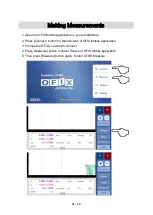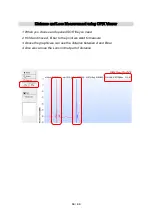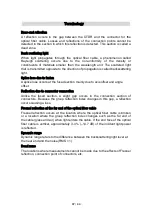
26
/
44
Fundamental of OTDR
OTDR
——Optical Time Domain Reflector is a high precision optical testing
meter
that use the theory of Rayleigh scattering and Fresnel reflection. It is widely used in
the maintenance, construction and monitoring of an optical line. All the important
parameters like fiber length, optical loss, connection loss, broken or twisted point and
etc. of a fiber can be shown on the OTDR. When the a light transmits along a fiber,
it would be scattered to various directions caused by the difference of come
properties of the transmission medium, this phenomenon called Rayleigh
scattering. During the scattering process, some of the light will be scattered along
the absolutely converse direction, this phenomenon is called Rayleigh back-
scattering. It provides some details about the fiber length. The parameters about
fiber length can be got by calculation with the parameter of time.
These back-scattering signals shows the loss level of a fiber and through these
information, OTDR can generates a backward oblique trace which reflects several
important attributes of an optical fiber. When the light, transmitting downward along
the fiber, meet a different density medium, a part of the light will be reflected, this
phenomenon is called Fresnel reflection. There are many reasons can cause the
changing of the medium density like a little slot at the splicing point, a broken of fiber
or etc. This phenomenon is usually used to locate the discontinuous point. Compare
to the Rayleigh scattering, the consuming amount of the light in Fresnel reflection is
much more then it is in Rayleigh scattering. The power of Fresnel reflection is tens of
thousands times to the back-scattering. The reflection level depends on the changing
grade of refraction ratio.
Formula of the distance: distance = (c/n) × (t/2)
Here:
c
is the light speed traveled in vacuum (2.998×108m/s)
t
is the delay between launching pulse and receiving pulse
n
is the refraction ratio of the testing fiber (specified by manufacturer)
When display the whole trace, each point of the trace represents the average value
of several sampling points. By zoom in and zoom out function, the value of each
sampling point can be got.
Summary of Contents for Ofix GP-1000
Page 1: ...1 44 OFIX V1 0 User s Manual...
Page 9: ...9 44 Names and Functions of Parts OFIX Interface 2 1 3 4 5 6 O F I X...
Page 11: ...11 44 OFIX LCD 2 1 4 5 6 7 3...
Page 13: ...13 44 OFIX Viewer PC 2 1 3 4 5 6 7 8...
Page 36: ...36 44 Background Information on Measurements Viewing the Optical Pulse Measurement Waveform...
Page 42: ...42 44 Dimension Unit mm...
















































